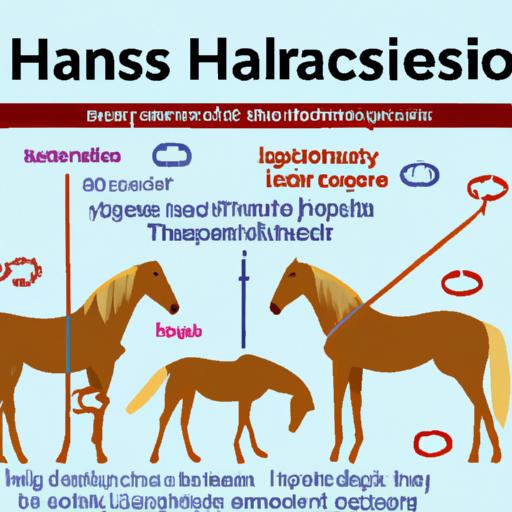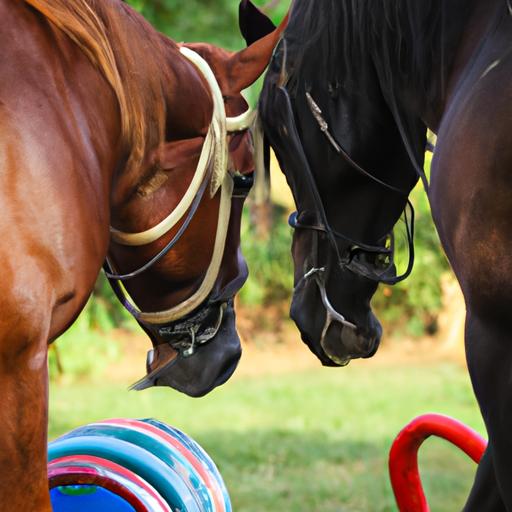Discover effective strategies for dealing with aggressive horse dominant behavior. Learn to recognize aggressive behaviors, handle dominance, and seek professional help if needed.
Introduction

As you step into the world of horses, one fascinating aspect that demands your attention is their social structure. Horses, being herd animals, establish a hierarchy within their groups, where dominant behavior plays a crucial role. In this article, we will delve into the intricacies of horse dominant behavior and its significance in equine management.
Definition of Horse Dominant Behaviour
When we talk about dominant behavior in horses, we refer to the interactions and behaviors displayed by horses to establish and maintain their rank within a herd. Dominance can manifest in various ways, including physical posturing, vocalizations, and even subtle gestures. Understanding these behaviors is vital to ensure effective equine management and promote harmonious relationships within a herd.
Importance of Understanding Horse Dominant Behaviour in Equine Management
Now, you might wonder, why is it so essential to comprehend horse dominant behavior? Well, the answer lies in the fact that horses are highly social creatures, and their hierarchical structure impacts their overall well-being. By observing and comprehending dominant behaviors, you can enhance your ability to manage and interact with horses, fostering a safe and respectful environment for both horse and human.
So, let’s embark on this enlightening journey to explore the fascinating world of horse dominant behavior. In the following sections, we will discuss the horse social hierarchy, indicators of dominant behavior, and effective strategies for managing and addressing this behavior. By the end of this article, you will have a deeper understanding of how to navigate the intricacies of equine hierarchy and build strong relationships with these majestic creatures.
Stay tuned for the next section, where we will uncover the secrets of horse social hierarchy and the roles horses play within their herds.
Understanding Horse Social Hierarchy

Explanation of Horse Herd Structure
To comprehend horse dominant behavior, we must first grasp the concept of their social structure. Horses naturally form herds, consisting of a group of individuals led by a dominant horse, often referred to as the alpha or herd leader. This hierarchical structure serves as a means of survival in the wild, allowing them to coordinate activities, protect each other, and maintain order within the group.
Within a horse herd, there is a clear pecking order, with dominant and subordinate roles. The dominant horse holds the highest rank and enjoys certain privileges, such as access to food, water, and preferred resting spots. Subordinate horses, on the other hand, have lower ranks and must adhere to the dominant horse’s authority.
Roles and Interactions within a Horse Herd
Each horse in a herd has a specific role and position within the hierarchy. Apart from the dominant horse, there are also subdominant horses and lower-ranking individuals. Subdominant horses may challenge the dominant horse’s authority but ultimately respect their position.
Interactions between horses within a herd are dynamic and fluid. Horses communicate through body language, vocalizations, and subtle cues. Dominant horses assert their authority through confident postures, such as upright ears, direct stares, and imposing body movements. Subordinate horses display submissive behaviors, such as lowered heads, averted eyes, and yielding to the dominant horse’s space.
Factors Influencing Dominance in Horses
Several factors contribute to the establishment of dominance in horses. Age and gender play significant roles, as older horses and stallions tend to have higher dominance ranks. Physical strength and assertiveness also influence a horse’s ability to establish dominance. Additionally, past experiences and individual personalities can shape a horse’s dominance behavior.
Understanding the intricacies of horse social hierarchy provides valuable insights into their behavior. In the next section, we will explore the indicators that help identify dominant behaviors in horses, enabling us to better comprehend their interactions and dynamics.
Identifying Dominant Behaviors in Horses
Understanding and recognizing dominant behaviors in horses is crucial for effective equine management. By being aware of the signs and indicators, you can better navigate the dynamics within a herd and address any potential conflicts. Let’s explore the various ways to identify dominant behaviors in horses.
Physical Signs of Dominance
Horses often display certain physical signs that indicate their dominant status within a herd. These signs can include:
-
Elevated Head Position: Dominant horses tend to hold their heads higher than their subordinates, showcasing their confidence and assertiveness.
-
Direct Eye Contact: Maintaining direct eye contact is a way for horses to assert dominance. A dominant horse may lock eyes with another horse, sending a clear message of superiority.
-
Aggressive Body Language: Dominant horses may exhibit aggressive body postures such as pinned ears, bared teeth, raised tail, and even charging or biting.
Behavioral Indicators of Dominance
Apart from physical cues, horses also communicate their dominance through their behavior. Look out for the following behavioral indicators:
-
Resource Guarding: Dominant horses may guard food, water, or preferred spaces, preventing others from accessing them.
-
Herd Movement Control: Dominant horses often dictate the movement of the herd, leading and directing other horses during grazing or when on the move.
-
Challenging and Herding Subordinates: Dominant horses may challenge subordinates by chasing, biting, or herding them, asserting their authority within the herd.
Communication Methods Used by Dominant Horses
Horses utilize a variety of communication methods to establish and maintain their dominance. These include:
-
Vocalizations: Dominant horses may make distinct vocalizations, such as loud neighs or snorts, to assert their presence and dominance.
-
Body Language: Watch for dominant horses using body language to communicate their status, such as arching their necks, flaring nostrils, or displaying dominant postures.
-
Physical Interactions: Dominant horses may engage in physical interactions like biting, kicking, or nudging to reinforce their dominance or discipline subordinates.
By paying attention to these physical signs, behavioral indicators, and communication methods, you can gain valuable insights into the dominant behaviors exhibited by horses. This knowledge will enable you to manage equine interactions effectively and create a harmonious environment within your herd.
In the next section, we will discuss essential techniques for managing dominant behavior in horses. Stay tuned!
Managing Dominant Behaviour in Horses
Horses, like any social animals, thrive in environments where clear leadership and boundaries are established. By effectively managing dominant behavior, you can create a harmonious and respectful relationship with your equine companion. In this section, we will explore key strategies for managing dominant behavior in horses.
A. Establishing Clear Leadership and Boundaries
Establishing yourself as a confident and consistent leader is crucial when dealing with dominant horses. Horses naturally seek guidance and feel more secure when they have a clear leader to follow. Here are some tips to establish your leadership:
-
Confidence: Display confidence in your interactions with the horse. Maintain a calm and assertive demeanor, as horses can sense your energy and respond accordingly.
-
Consistency: Be consistent in your expectations and commands. Set clear boundaries and enforce them consistently. This helps horses understand the rules and reduces the likelihood of dominant behavior.
-
Respectful Communication: Use clear and concise cues when interacting with your horse. Employing positive reinforcement techniques can encourage desired behaviors and foster mutual respect.
B. Consistent Training and Handling Techniques
Consistent training and handling techniques are essential to manage dominant behavior effectively. Here are some practices to consider:
-
Groundwork: Incorporate groundwork exercises into your training routine to establish respect and obedience. These exercises can include lunging, yielding, and desensitization techniques.
-
Reward-Based Training: Utilize positive reinforcement techniques to reward desired behaviors. This helps reinforce positive associations and encourages horses to respond positively to your cues.
-
Consistent Routine: Maintain a consistent daily routine for your horse, including feeding, turnout, and exercise schedules. Consistency provides a sense of security and stability, reducing the likelihood of challenging behaviors.
C. Providing Adequate Social Interaction and Turnout Time
Horses are social animals and thrive on social interactions. Providing adequate socialization opportunities and turnout time can help manage dominant behavior. Consider the following:
-
Herd Interaction: Allow your horse to interact with compatible herd members regularly. This promotes natural socialization and helps establish and maintain their place within the herd hierarchy.
-
Turnout Time: Ensure your horse has access to regular turnout time in a safe and spacious environment. This allows them to engage in natural behaviors, reducing stress and potential dominance-related issues.
By implementing these strategies, you can effectively manage and address dominant behavior in horses, fostering a balanced and respectful relationship. In the next section, we will explore the topic of aggressive dominant behavior and how to handle it appropriately.
Conclusion
Understanding and addressing horse dominant behavior is paramount for any equine enthusiast or caretaker. By familiarizing ourselves with the intricacies of the horse social hierarchy and recognizing dominant behaviors, we can create a harmonious environment for both horses and humans.
Throughout this article, we have explored the definition of horse dominant behavior and its importance in equine management. We have learned about the roles and interactions within a horse herd, as well as the various indicators of dominant behavior. By identifying these behaviors, we can take proactive measures to manage and address them effectively.
When dealing with aggressive dominant behavior, it is crucial to recognize the signs early on. By understanding the behaviors associated with aggression, we can implement appropriate strategies to handle and redirect this behavior. Establishing clear boundaries, consistent training, and providing ample social interaction and turnout time are essential in managing aggressive dominance.
However, in some cases, seeking professional help may be necessary. Trained equine behavior specialists can provide valuable guidance and support in addressing aggressive dominant behavior, ensuring the safety and well-being of both horses and handlers.
In conclusion, horse dominant behavior is a fascinating aspect of equine life that demands our attention. By embracing our role as knowledgeable caretakers, we can create a nurturing environment that fosters healthy relationships within the herd. Remember, at Horsemasterypro.com, we strive to provide you with the tools and knowledge to enhance your equine management skills and build a deep bond with these magnificent animals.
Stay tuned for more insightful articles on horsemanship and equine behavior. Together, let’s unlock the secrets of the horse-human connection and embark on a remarkable journey of horsemanship mastery.


